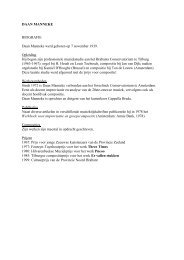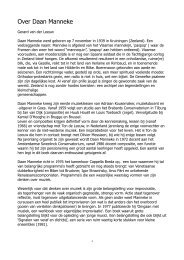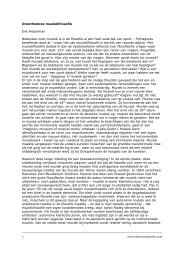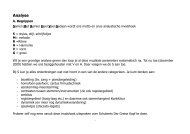Anton Webern and the influence of Heinrich Isaac
Anton Webern and the influence of Heinrich Isaac
Anton Webern and the influence of Heinrich Isaac
You also want an ePaper? Increase the reach of your titles
YUMPU automatically turns print PDFs into web optimized ePapers that Google loves.
Example 6: Prime order <strong>of</strong> <strong>the</strong> row for movement two <strong>of</strong> <strong>Webern</strong>’s Op. 21.<br />
However, as Whittall has pointed out, ‘<strong>the</strong> last thing <strong>Webern</strong> aspired to in this work<br />
was a mechanically predictable succession <strong>of</strong> palindromes…such obviousness could<br />
not be expected to appeal to a composer <strong>of</strong> such motivic concentration <strong>and</strong> subtlety’<br />
(Whittall, 1999: 207). Ra<strong>the</strong>r, he sought to create <strong>the</strong> highest unity, yet avoided<br />
banality by varying <strong>the</strong> extent to which <strong>the</strong> symmetry was exact.<br />
As <strong>Webern</strong>’s self-comparison with <strong>the</strong> Ne<strong>the</strong>rl<strong>and</strong>ers suggests he had<br />
observed techniques similar to those he employed in <strong>the</strong> Symphony in <strong>the</strong>ir music.<br />
Choralis Constantinus contains two particularly good examples, which may well have<br />
been an inspiration to <strong>Webern</strong>. In <strong>the</strong> Sequentia <strong>of</strong> Office X (p.80), <strong>the</strong>re is a crab<br />
canon lasting eleven minim beats (starting on <strong>the</strong> second minim <strong>of</strong> bar 1 <strong>and</strong> ending<br />
on <strong>the</strong> second minim <strong>of</strong> bar 6), between <strong>the</strong> tenor <strong>and</strong> <strong>the</strong> discantus (see Example 7).<br />
Example 7: <strong>Heinrich</strong> <strong>Isaac</strong>, Choralis Constantinus, Book II, Office X.<br />
While this canon does not exhibit perfect symmetry, certain features give it a strong<br />
symmetrical sense that <strong>Webern</strong> surely picked up on. The melody <strong>of</strong> <strong>the</strong> discantus is an<br />
exact retrograde <strong>of</strong> <strong>the</strong> tenor part (except for <strong>the</strong> naturalised B’s before <strong>the</strong> cadence).<br />
This results in a strong unity <strong>and</strong> similarity <strong>of</strong> intervalic relationships between <strong>the</strong><br />
parts on ei<strong>the</strong>r side <strong>of</strong> <strong>the</strong> point <strong>of</strong> symmetry (beat one <strong>of</strong> bar 4). The symmetry is<br />
more clearly indicated by Example 8 where it will be noted that ei<strong>the</strong>r side <strong>of</strong> <strong>the</strong><br />
11





![Schubert, Winterreise: Einsamkeit [PDF] - bestmusicteacher.com](https://img.yumpu.com/21166489/1/190x135/schubert-winterreise-einsamkeit-pdf-bestmusicteachercom.jpg?quality=85)

![Schubert, Winterreise: Die Nebensonnen [PDF] - Bestmusicteacher ...](https://img.yumpu.com/20295219/1/190x135/schubert-winterreise-die-nebensonnen-pdf-bestmusicteacher-.jpg?quality=85)
